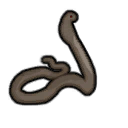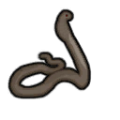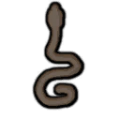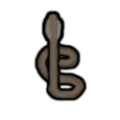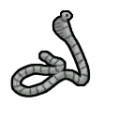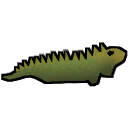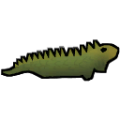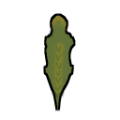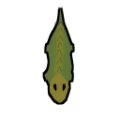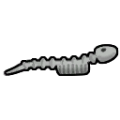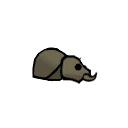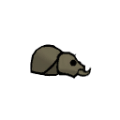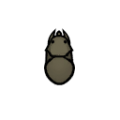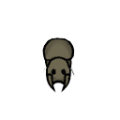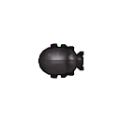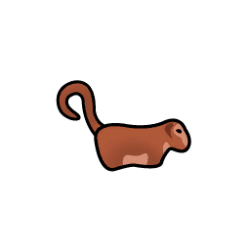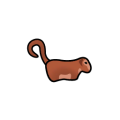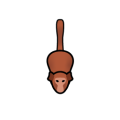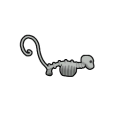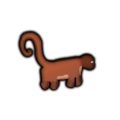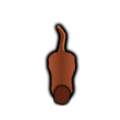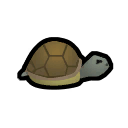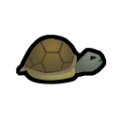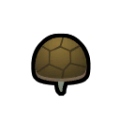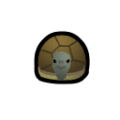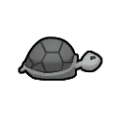Difference between revisions of "Omnivore"
(Initial page creation) |
(Added text. Added omnivorous animals not already listed.) |
||
| Line 1: | Line 1: | ||
| + | Omnivores are creatures that will eat [[plants]] or [[meat]]. They usually rely on wild plants for sustenance but will eat any [[food]] left lying about like raw meat, vegetables, prepared [[meals]], [[chocolate]], and [[beer]]. | ||
| + | |||
| + | <div style="clear:both;"> | ||
<div class="pull-left">{{:Boomrat}}</div> | <div class="pull-left">{{:Boomrat}}</div> | ||
| + | <div class="pull-left">{{:Cobra}}</div> | ||
<div class="pull-left">{{:Iguana}}</div> | <div class="pull-left">{{:Iguana}}</div> | ||
| + | </div> | ||
| + | <div style="clear:both;"> | ||
<div class="pull-left">{{:Megascarab}}</div> | <div class="pull-left">{{:Megascarab}}</div> | ||
| + | <div class="pull-left">{{:Monkey}}</div> | ||
| + | <div class="pull-left">{{:Tortoise}}</div> | ||
| + | </div> | ||
{{nav|animal}} | {{nav|animal}} | ||
[[Category:Animals]] | [[Category:Animals]] | ||
[[Category:Wild]] | [[Category:Wild]] | ||
Revision as of 01:13, 5 June 2015
Omnivores are creatures that will eat plants or meat. They usually rely on wild plants for sustenance but will eat any food left lying about like raw meat, vegetables, prepared meals, chocolate, and beer.
Cobra
A large predatory snake. Cobras can be highly aggressive if provoked, and their bite injects toxic venom into the victim.
Base Stats
- Type
- Animal
- Flammability
- 70%
Pawn Stats
- Combat Power
- 65
- Move Speed
- 3.5 c/s
- Health Scale
- 0.5
- Body Size
- 0.25
- Mass - Baby
- 3 kg
- Mass - Juvenile
- 7.5 kg
- Mass - Adult
- 15 kg
- Carrying Capacity
- 19 kg
- Filth Rate
- 1
- Hunger Rate
- 0.11 Nutrition/Day
- Diet
- carnivorous, ovivorous
- Life Expectancy
- 20 years
- Manhunter Chance
- 50%
- Manhunter Chance (Taming)
- 10%
- Trainable Intelligence
- None
- Wildness
- 75%
- Minimum Handling Skill
- 7
- Mate Interval
- 12 hours
- Maturity Age
- 0.5 years (30 days)
- Juvenile Age
- 0.15 years (9 days)
- Comfortable Temp Range
- 0 °C – 60 °C (32 °F – 140 °F)
Production
- Meat Yield
- 36 cobra meat
- Leather Yield
- 18 lizardskin
- Eggs Per Clutch
- 1 to 2
- Egg Laying Interval
- 10 days
- Can Lay Unfertilized Eggs
- false
Melee Combat
- Attack 1
- Mouth
12 dmg (Toxic bite)
18 % AP
2 second cooldown
Stun for 280 ticks (4.67 secs) on first strike - Attack 2
- Head
3 dmg (Blunt)
4 % AP
2 second cooldown
0.2 chance factor - Average DPS
- 2.33
- tradeTags
- AnimalUncommon, AnimalFighter
Cobras are predatory and ovivorous snakes found only in tropical rainforests and tropical swamps. They eat smaller animals, and sometimes people if they don't find a smaller prey in time.
Their bite causes toxic buildup.[How much?] The toxic buildup from their bite is not applied when they are hunting, to prevent rotting their would-be prey and leaving them unable to eat it.
Analysis
In a tropical biome, cobras are a persistent threat to your small animals, children,![]() and possibly to unarmed adults. When fighting a single cobra, its toxic bite is unlikely to make a difference, at least with adult colonists. However, the toxins can add up when fighting a manhunter pack of cobras. It can also matter when a cobra fights smaller targets.
and possibly to unarmed adults. When fighting a single cobra, its toxic bite is unlikely to make a difference, at least with adult colonists. However, the toxins can add up when fighting a manhunter pack of cobras. It can also matter when a cobra fights smaller targets.
There's not much reason to tame a cobra, or keep a tamed cobra. Cobras cannot be trained to attack, and even if you use allowed areas to force a cobra to fight, it is one of the weakest predators in the game. In the tropics, you have access to elephants. Elephants are one of the strongest animals in the game, can be trained to attack, can graze on grass, and are just as easy to tame. In addition, elephants will not go manhunter on a failed taming attempt. For meat, tortoises are strictly better.
Training
This animal can be trained as follows:
| Guard: | |
|---|---|
| Attack: | |
| Rescue: | |
| Haul: |
*As of version 1.1.2610, all animals can be tamed. The percentage of likelihood of success depends on factors such as the Animals Wildness Percentage, Pawn Handling Skill, and others. More information can be found on the animals page.
Health
| Part Name | Health | Quantity | Coverage[1] | Target Chance[2] | Subpart of | Internal | Capacity[3] | Effect if Destroyed/Removed |
|---|---|---|---|---|---|---|---|---|
| Body | 30 | 1 | 100% | 55% | N/A[4] | Moving | Death | |
| Head | 30 | 1 | 20% | 4% | Body | Hearing | Death | |
| Skull | 25 | 1 | 30.0% | 3% | Head | - | Cannot be destroyed Increasing Pain based on damage. | |
| Brain | 10 | 1 | 50.0% | 3% | Skull | Consciousness | Death Damage always results in scarring. | |
| Eye | 10 | 2 | 10.0% | 2% | Head | Sight | −25% Sight. −100% if both lost. Damage always results in scarring. 0% Hit Chance against Blunt damage. | |
| Nose | 10 | 1 | 15.0% | 3% | Head | - | - | |
| Mouth | 20 | 1 | 15.0% | 3% | Head | Manipulation Eating Talking |
Cannot be destroyed Up to −96% Manipulation Up to −96% Eating Up to −96% Talking | |
| Heart | 15 | 1 | 3% | 3% | Torso | Blood Pumping | Death | |
| Lung | 15 | 2 | 3% | 3% | Torso | Breathing | −50% Breathing. Death if both lost | |
| Stomach | 20 | 1 | 5% | 5% | Torso | Metabolism | −50% Metabolism | |
| Liver | 20 | 1 | 5% | 5% | Torso | Blood Filtration Metabolism |
Death | |
| Kidney | 15 | 2 | 3% | 3% | Torso | Blood Filtration | −50% Blood Filtration. Death if both lost |
- ↑ Coverage determines the chance to hit this body part. It refers to the percentage of the super-part that this part covers, before its own sub-parts claim their own percentage. For example, if the base coverage of the super-part is 100%, and the coverage of the part is 20%, 20% of hits would hit the part, and 80% the super-part. If the part had its own sub-part with 50% coverage, the chances would be 10% sub-part, 10% part, 80% super part.
- ↑ Target Chance is the actual chance for each part to be be selected as the target when each part's coverage has been taken into account(I.E. Neck covers 7.5% of Torso but Head covers 80% of Neck so it actually has only a 1.5% chance to be selected). This is not pure hit chance, as different damage types propagate damage in different ways. See that page for details.
- ↑ Note that capacities can affect other capacities in turn. Only the primary effect is listed. See specific pages for details.
- ↑ This is the part that everything else connects to to be considered 'connected'.
Trivia
Unlike in real life and most animals in RimWorld, cobras have no skeletons besides their skull.
Gallery
Version history
- 0.7.581 - Added
- 0.12.906 - Can now lay eggs
- 0.18/1.0 - Now provides the new lizardskin, which merged its previous leather type, cobraskin, with tortoise leather and iguana skin.
- Somewhere between 1.2.2719 and 1.3.3200 - Cobras no longer use their venom when hunting. Previously, cobras had a tendency to inadvertently destroy entire ecosystems when hungry. Predators hunt when hungry, but the cobra's bite inflicted toxic buildup which caused the prey's corpse to rot. This prevented the cobra from being able to eat the corpse, which left them hungry, so they'd go hunting again and the cycle repeated. Eventually they'd leave a string of rotting animals corpses and still end up malnourished.
Iguana
These large lizards normally feed on plant matter. However, when angered, their tough hide and sharp claws make them quite dangerous.
Resting iguanas hold their heads high, giving them an amusing 'proud' look. But they're not proud; they're just trying to see predators so they don't get eaten.
Base Stats
- Type
- Animal
- Flammability
- 70%
Pawn Stats
- Combat Power
- 40
- Move Speed
- 3 c/s
- Health Scale
- 0.5
- Body Size
- 0.4
- Mass - Baby
- 4.8 kg
- Mass - Juvenile
- 12 kg
- Mass - Adult
- 24 kg
- Carrying Capacity
- 30 kg
- Filth Rate
- 1
- Hunger Rate
- 0.32 Nutrition/Day
- Diet
- omnivorous grazer
- Life Expectancy
- 12 years
- Manhunter Chance
- 0%
- Manhunter Chance (Taming)
- 0%
- Trainable Intelligence
- None
- Wildness
- 50%
- Minimum Handling Skill
- 4
- Mate Interval
- 12 hours
- Maturity Age
- 0.222 years (13.3 days)
- Juvenile Age
- 0.1 years (6 days)
- Comfortable Temp Range
- 0 °C – 60 °C (32 °F – 140 °F)
Production
- Meat Yield
- 56 iguana meat
- Leather Yield
- 22 lizardskin
- Eggs Per Clutch
- 1 to 2
- Egg Laying Interval
- 5.661 days
- Can Lay Unfertilized Eggs
- false
Melee Combat
- Attack 1
- Front left claws
8 dmg (Scratch)
12 % AP
2 second cooldown - Attack 2
- Front right claws
8 dmg (Scratch)
12 % AP
2 second cooldown - Attack 3
- Teeth
10 dmg (Bite)
15 % AP
2.6 second cooldown
0.7 chance factor - Attack 4
- Head
5 dmg (Blunt)
7 % AP
2 second cooldown
0.2 chance factor - Average DPS
- 2.22
- tradeTags
- AnimalUncommon
Summary
Iguanas have 95% Toxic Environment Resistance rendering them highly resistant to environmental effects such as rot stink and toxic buildup from non-attack sources.
Analysis
Other than being a meager source of food for desert and extreme desert starts, iguanas have very little niche.
They are the only omnivore in the desert / extreme desert. They'll eat any food they have access to, which is usually your own, so think of iguanas as desert rats. Like rats, tamed iguanas have a small niche as they can eat and dispose of corpses.
Training
This animal can be trained as follows:
| Guard: | |
|---|---|
| Attack: | |
| Rescue: | |
| Haul: |
*As of version 1.1.2610, all animals can be tamed. The percentage of likelihood of success depends on factors such as the Animals Wildness Percentage, Pawn Handling Skill, and others. More information can be found on the animals page.
Health
Gallery
Version history
- 0.12.906 - Can now lay eggs
- 0.18/1.0 - Now provides the new lizardskin, which merged its previous leather type, iguana skin, with tortoise leather and cobraskin.
Megascarab
A large, genetically-engineered beetle. Once the worker caste of an artificial ecosystem of insectoids designed to fight mechanoid invasions, it is now often seen without its deadlier insectoid cousins. Still, its size and hard shell make it dangerous when it attacks. A eusocial creature, it cannot reproduce individually.
Base Stats
Apparel
- Armor - Sharp
- 72%
- Armor - Blunt
- 18%
Pawn Stats
- Combat Power
- 40
- Move Speed
- 3.75 c/s
- Health Scale
- 0.4
- Body Size
- 0.2
- Mass - Baby
- 2.4 kg
- Mass - Juvenile
- 6 kg
- Mass - Adult
- 12 kg
- Carrying Capacity
- 15 kg
- Filth Rate
- 1
- Hunger Rate
- 0.16 Nutrition/Day
- Diet
- omnivorous, animal products
- Life Expectancy
- 10 years
- Manhunter Chance
- 50%
- Manhunter Chance (Taming)
- 0%
- Trainable Intelligence
- Intermediate
- Wildness
- 20%
- Minimum Handling Skill
- 1
- Maturity Age
- 0.4 years (24 days)
- Juvenile Age
- 0.03 years (1.8 days)
- Comfortable Temp Range
- 0 °C – 60 °C (32 °F – 140 °F)
Production
- Meat Yield
- 31 insect meat
Melee Combat
- Attack 1
- Mouth
5 dmg (Bite)
7 % AP
2 second cooldown - Attack 2
- Head
4 dmg (Blunt)
6 % AP
2 second cooldown
0.1 chance factor - Average DPS
- 1.68
- tradeTags
- AnimalInsect
Megascarabs are a type of Insectoid found in regular and extreme deserts, infestations or inside ancient shrines, including inside the caskets.
Summary
They are ground beetles of metallic color that posses elytra, a protective shell that provides some armor. Megascarabs are hazardous to hunt, for if they are injured by a human or a mechanoid, they will turn manhunter and attack any human or mechanoid on the map they can reach. If slain, they can be butchered for insect meat. Colonists dislike eating any insect meat, but meat-eating animals have no such problem.
All insectoids, including the omnivore, experience hypothermic slowdown instead of fatal hypothermia, have 100% Toxic Resistance, rendering them immune to toxic buildup from any source, and 80% Toxic Environment Resistance, rendering them resistant to environmental effects such as rot stink. They experience also pollution stimulus when in polluted terrain.![]() See that page for full details.
See that page for full details.
Insectoids are incapable of sexual reproduction like other animals, due to their breeding type (EusocialInsect). Instead, wild insects reproduce via hives which create new insectoids periodically, up to a maximum value each hive can support. Tamed insectoids cannot reproduce at all. For more detail, see the Hive page.
Armor
| Armor |
|---|
Analysis
Combat
Megascarabs are the smallest and fastest of the 3 insectoid types, and will often catch up to colonists and "lock" them into melee. It may be wiser to focus on bigger targets, like megaspiders, as they are stronger in combat.
Melee block tactics work well against infestations in general. In an open field, kiting works well, as even megascarabs are slower than a healthy human.
Taming
Megascarabs offer no real niche as a tamed pet, however they can be tamed. Unlike the larger insects, they can generate non-hostile, and are found naturally in deserts.
Training
This animal can be trained as follows:
| Guard: | |
|---|---|
| Attack: | |
| Rescue: | |
| Haul: |
*As of version 1.1.2610, all animals can be tamed. The percentage of likelihood of success depends on factors such as the Animals Wildness Percentage, Pawn Handling Skill, and others. More information can be found on the animals page.
Health
Gallery
Version history
- Beta 19/1.0 - All insects main attack cooldowns 2.5 -> 2.9
- Some time between A6 and A13 - Sprite changed.
- 1.3 - Revenge on tame fail decreased from 20% to 10% - revenge on harm increased from 35% to 50% - wildness decreased from 95% to 20%.
- Biotech DLC release - Now gains pollution stimulus on polluted terrain.
Monkey
A small primate, the monkey can use its curly tail to grab on to branches, leaving its hands free to do other things. Monkeys are selfish but clever, and can be trained to carry out fairly complex tasks.
Base Stats
- Type
- Animal
- Flammability
- 70%
Pawn Stats
- Combat Power
- 35
- Move Speed
- 4.3 c/s
- Health Scale
- 0.45
- Body Size
- 0.35
- Mass - Baby
- 4.2 kg
- Mass - Juvenile
- 10.5 kg
- Mass - Adult
- 21 kg
- Carrying Capacity
- 26 kg
- Filth Rate
- 1
- Hunger Rate
- 0.2 Nutrition/Day
- Diet
- omnivorous grazer
- Life Expectancy
- 30 years
- Manhunter Chance
- 0%
- Manhunter Chance (Taming)
- 0%
- Trainable Intelligence
- Intermediate
- Wildness
- 60%
- Minimum Handling Skill
- 5
- Nuzzle Interval
- 1 day
- Mate Interval
- 12 hours
- Maturity Age
- 0.266 years (16 days)
- Juvenile Age
- 0.2 years (12 days)
- Comfortable Temp Range
- -5 °C – 50 °C (23 °F – 122 °F)
Production
- Meat Yield
- 49 monkey meat
- Leather Yield
- 21 lightleather
- Gestation Period
- 6.66 days
- Offspring Per Birth
- 1
Melee Combat
- Attack 1
- Left hand
3.6 dmg (Blunt)
5 % AP
1.5 second cooldown - Attack 2
- Right hand
3.6 dmg (Blunt)
5 % AP
1.5 second cooldown - Attack 3
- Teeth
4 dmg (Bite)
6 % AP
2 second cooldown
0.7 chance factor - Attack 4
- Head
2 dmg (Blunt)
3 % AP
2 second cooldown
0.2 chance factor - Average DPS
- 1.21
- tradeTags
- AnimalUncommon
Analysis
Monkeys are small and have relatively low damage, making them poor as actual tame animals. They cannot haul, either.
However, monkeys are one of the few animals that can nuzzle, giving a +4 Nuzzled moodlet to colonists. They are one of 2 nuzzlers, along with the guinea pig, that can be found in the wild. Note that the guinea pig eats less, produces more offspring, and is just as difficult to tame, though is a rarer animal.
Training
This animal can be trained as follows:
| Guard: | |
|---|---|
| Attack: | |
| Rescue: | |
| Haul: |
*As of version 1.1.2610, all animals can be tamed. The percentage of likelihood of success depends on factors such as the Animals Wildness Percentage, Pawn Handling Skill, and others. More information can be found on the animals page.
Health
| Part Name | Health | Quantity | Coverage[1] | Target Chance[2] | Subpart of | Internal | Capacity[3] | Effect if Destroyed/Removed |
|---|---|---|---|---|---|---|---|---|
| Torso | 40 | 1 | 100% | 15% | N/A[4] | – | Death | |
| Neck | 25 | 1 | 10% | 2.8% | Torso | Breathing Eating Talking |
Death | |
| Head | 25 | 1 | 72% | 1.6% | Neck | – | Death | |
| Skull | 25 | 1 | 18.0% | 0.39% | Head | – | Cannot be destroyed Increasing Pain based on damage. | |
| Brain | 10 | 1 | 70.0% | 0.91% | Skull | Consciousness | Death Damage always results in scarring. | |
| Eye | 10 | 2 | 12.0% | 0.86% | Head | Sight | −25% Sight. −100% if both lost. Damage always results in scarring. 0% Hit Chance against Blunt damage. | |
| Ear | 12 | 2 | 8.0% | 0.58% | Head | Hearing | −25% Hearing. −100% if both lost. | |
| Nose | 10 | 1 | 10.0% | 0.72% | Head | – | – | |
| Jaw | 10 | 1 | 10.0% | 0.72% | Head | Manipulation | −33% Manipulation | |
| Tail | 10 | 1 | 2% | 2% | Torso | – | – | |
| Spine | 25 | 1 | 3% | 3% | Torso | Moving | −100% Moving[5] | |
| Ribcage | 30 | 1 | 4.5% | 4.5% | Torso | Breathing | Cannot be destroyed Up to −48% Breathing Increasing Pain based on damage. | |
| Sternum | 20 | 1 | 0.5% | 0.5% | Torso | Breathing | Cannot be destroyed Up to −48% Breathing Increasing Pain based on damage. | |
| Heart | 15 | 1 | 3% | 3% | Torso | Blood Pumping | Death | |
| Lung | 15 | 2 | 3% | 3% | Torso | Breathing | −50% Breathing. Death if both lost | |
| Stomach | 20 | 1 | 4% | 4% | Torso | Metabolism | −50% Metabolism | |
| Liver | 20 | 1 | 3% | 3% | Torso | Blood Filtration Metabolism |
Death | |
| Kidney | 15 | 2 | 3% | 3% | Torso | Blood Filtration | −50% Blood Filtration. Death if both lost | |
| Shoulder | 30 | 2 | 10.0% | 1.5% | Torso | Manipulation | −33% Manipulation. −67% if both lost | |
| Arm | 30 | 2 | 85.0% | 4.7% | Shoulder | Manipulation | −33% Manipulation. −67% if both lost | |
| Clavicle | 25 | 2 | 1% | 1% | Torso | Manipulation | – | |
| Humerus | 25 | 2 | 10.0% | 0.85% | Arm | Manipulation | −33% Manipulation. −67% if both lost | |
| Radius | 20 | 2 | 10.0% | 0.85% | Arm | Manipulation | −33% Manipulation. −67% if both lost | |
| Hand | 20 | 2 | 25.0% | 0.68% | Arm | Manipulation | −33% Manipulation. −67% if both lost | |
| Pinky Finger | 8 | 2 | 11.0% | 0.23% | Hand | Manipulation | −5% Manipulation. −11% if both lost | |
| Ring Finger | 8 | 2 | 13.0% | 0.28% | Hand | Manipulation | −5% Manipulation. −11% if both lost | |
| Middle Finger | 8 | 2 | 15.0% | 0.32% | Hand | Manipulation | −5% Manipulation. −11% if both lost | |
| Index Finger | 8 | 2 | 14.0% | 0.30% | Hand | Manipulation | −5% Manipulation. −11% if both lostt | |
| Thumb | 8 | 2 | 15.0% | 0.32% | Hand | Manipulation | −5% Manipulation. −11% if both lost | |
| Pelvis | 25 | 1 | 1% | 1% | Torso | Moving | Cannot be destroyed Up to −96% Moving. | |
| Leg | 30 | 2 | 10.0% | 6% | Torso | Moving | −50% Moving. −100% if both lost | |
| Femur | 25 | 2 | 10.0% | 1% | Leg | Moving | −50% Moving. −100% if both lost | |
| Tibia | 25 | 2 | 10.0% | 1% | Leg | Moving | −50% Moving. −100% if both lost | |
| Left foot | 25 | 1 | 20.0% | 0.66% | Leg | Moving | −50% Moving. −100% if both lost | |
| Right foot | 25 | 1 | 20.0% | 0.64% | Leg | Moving | −50% Moving. −100% if both lost | |
| Left little Toe | 8 | 1 | 10.0% | 0.20% | Foot | Moving | −4% Moving. −8% if both lost | |
| Right little Toe | 8 | 1 | 11.0% | 0.22% | Foot | Moving | −4% Moving. −8% if both lost | |
| Fourth Toe | 8 | 2 | 12.0% | 0.24% | Foot | Moving | −4% Moving. −8% if both lost | |
| Middle Toe | 8 | 2 | 14.0% | 0.28% | Foot | Moving | −4% Moving. −8% if both lost | |
| Second Toe | 8 | 2 | 15.0% | 0.30% | Foot | Moving | −4% Moving. −8% if both lost | |
| Big Toe | 8 | 2 | 16.0% | 0.32% | Foot | Moving | −4% Moving. −8% if both lost |
- ↑ Coverage determines the chance to hit this body part. It refers to the percentage of the super-part that this part covers, before its own sub-parts claim their own percentage. For example, if the base coverage of the super-part is 100%, and the coverage of the part is 20%, 20% of hits would hit the part, and 80% the super-part. If the part had its own sub-part with 50% coverage, the chances would be 10% sub-part, 10% part, 80% super part.
- ↑ Target Chance is the actual chance for each part to be be selected as the target when each part's coverage has been taken into account(I.E. Neck covers 7.5% of Torso but Head covers 80% of Neck so it actually has only a 1.5% chance to be selected). This is not pure hit chance, as different damage types propagate damage in different ways. See that page for details.
- ↑ Note that capacities can affect other capacities in turn. Only the primary effect is listed. See specific pages for details.
- ↑ This is the part that everything else connects to to be considered 'connected'.
- ↑ If Moving drops below 16% a pawn cannot move.
Gallery
Trivia
The updated monkey texture was originally part of the Vanilla Textures Expanded mod, but was integrated into the base game by agreement.[1]
Version history
- 0.7.581 - Added.
- Beta 19/ 1.0 - nuzzle interval 72 -> 48 hours
Tortoise
This heavily armored land-dwelling reptile is known for its slow moving speed and surprisingly vicious bite. Because of its natural armor, it is tough to kill and can do serious damage during drawn-out melee fights.
Base Stats
- Type
- Animal
- Flammability
- 70%
Apparel
- Armor - Sharp
- 50%
- Armor - Blunt
- 35%
Pawn Stats
- Combat Power
- 70
- Move Speed
- 1 c/s
- Health Scale
- 0.6
- Body Size
- 0.5
- Mass - Baby
- 6 kg
- Mass - Juvenile
- 15 kg
- Mass - Adult
- 30 kg
- Carrying Capacity
- 38 kg
- Filth Rate
- 1
- Hunger Rate
- 0.13 Nutrition/Day
- Diet
- omnivorous grazer
- Life Expectancy
- 180 years
- Manhunter Chance
- 0%
- Manhunter Chance (Taming)
- 0%
- Trainable Intelligence
- None
- Wildness
- 75%
- Minimum Handling Skill
- 7
- Mate Interval
- 12 hours
- Maturity Age
- 0.222 years (13.3 days)
- Juvenile Age
- 0.15 years (9 days)
- Comfortable Temp Range
- 0 °C – 50 °C (32 °F – 122 °F)
Production
- Meat Yield
- 70 tortoise meat
- Leather Yield
- 25 lizardskin
- Eggs Per Clutch
- 1 to 3
- Egg Laying Interval
- 6.66 days
- Can Lay Unfertilized Eggs
- false
Melee Combat
- Attack 1
- Beak
8 dmg (Bite)
12 % AP
2.6 second cooldown - Attack 2
- Head
3 dmg (Blunt)
4 % AP
2.6 second cooldown
0.2 chance factor - Average DPS
- 1.12
- tradeTags
- AnimalUncommon
Tortoises are crawling omnivores which live in the moderate climates of the temperate forest and temperate swamp, and the sweltering humidity of the tropical rainforest and tropical swamp.
Analysis
Tortoises are the single best animal for meat : nutrition input, or nutrition efficiency. This is due to their remarkably low hunger rate. A tortoise farm can also produce a lot of leather. However, tortoises are not pen animals. They must be re-tamed every Expression error: Unexpected round operator. days, or carefully slaughtered just before they become un-tame, which requires a lot of micromanagement. Players may prefer to ranch animals like the ibex and horse, as they do not require nearly as much work to farm.
Nutrition
When slaughtered, a tortoise yields Expression error: Unexpected < operator. meat and Expression error: Unexpected < operator. lizardskin as a baby; Expression error: Unexpected < operator. meat and Expression error: Unexpected < operator. lizardskin as a juvenile; or Expression error: Unexpected < operator. meat and Expression error: Unexpected < operator. lizardskin as an adult. 1 meat is worth 0.05 nutrition. A tortoise's fertilized egg only provides 0.25 nutrition, compared to the Expression error: Unexpected < operator. of a butchered baby. Therefore, a tortoise should always be allowed to hatch.
An adult tortoise consumes nutrition per day, and a fertilized female creates an average of Expression error: Unexpected / operator. offspring per day.
- When offspring are slaughtered as babies, a female tortoise will produce Expression error: Unexpected < operator. nutrition of meat per day, giving a potential nutrition efficiency of Expression error: Unexpected < operator.%.
- If the offspring are allowed to grow to adulthood, they will consume an additional Expression error: Unexpected < operator. nutrition per day, but will instead yield Expression error: Unexpected < operator. nutrition per day as they are slaughtered, resulting in a potential nutrition efficiency of Expression error: Unexpected < operator.%.
This does not consider the food required of male tortoises. A female:male ratio of Expression error: Unexpected / operator.:1 reaches an optimal fertilization rate. With this ratio of tortoises, you reach a "true" nutrition efficiency of Expression error: Unexpected < operator.%. For reference, the next best animal, the chicken, has a nutrition efficiency of 178.6%, after considering their female:male ratio. Chickens do not produce leather. The next best animal that produces leather is the ibex.
Some care must be used when managing tortoise eggs, as tortoises themselves are omnivorous and do not seem to discriminate against eating their unhatched young. Make use of restriction zones and hauling labor to pull freshly laid eggs away from animal pens and into safe hatcheries to maximize yield.
Combat
Turtles are poor animals for combat. They do little damage, and due to their low health scale, they aren't durable, either. Turtles can occasionally be seen beating much larger predators, such as lynx and cougars. This isn't because tortoises are great at combat, but rather a consequence of RimWorld's combat RNG. Armor has a chance to completely negate damage, so turtles have a higher-than-usual chance to win. And if a tortoise loses, you usually won't see their corpse (it'll be consumed right away).
Because of their low damage and high-ish armor, turtles can be used to train the Melee and Medical skills. A well-armored colonist can land many melee blows on a tortoise without much risk. This trains their Melee skill. A doctor can tend to the colonist's and turtle's wounds, which trains Medical. Rinse and repeat a few times until the poor beast finally dies. Note that beating up human prisoners is even less of a risk (prisoners do not fight back).
As manhunters, tortoises are trivial to deal with, due to their slow speed. If you have any sort of ranged weapon, kiting tactics can be used to easily defeat a tortoise pack. Even if you don't have a ranged weapon, you could run to the nearest door and close it.
Training
This animal can be trained as follows:
| Guard: | |
|---|---|
| Attack: | |
| Rescue: | |
| Haul: |
*As of version 1.1.2610, all animals can be tamed. The percentage of likelihood of success depends on factors such as the Animals Wildness Percentage, Pawn Handling Skill, and others. More information can be found on the animals page.
Health
Armor
| Armor |
|---|
Gallery
Version history
- 0.7.581 - Added.
- 0.12.906 - Can now lay eggs.
- 0.18/1.0 - Now provides the new lizardskin, which merged its previous leather type, tortoise leather, with cobraskin and iguana skin.
- 1.0 - Tortoise armor was reduced from 50% to 30%.
- ? - Armor increased back up to 50%.
